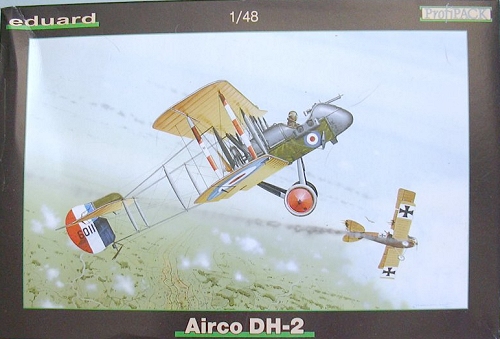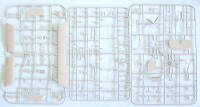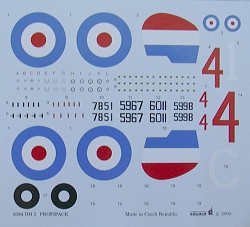
| KIT: | Eduard 1/48 Airco DeHavilland DH.2 |
| KIT #: | 8094 |
| PRICE: | $34.95 MSRP |
| DECALS: | Four options |
| REVIEWER: | Tom Cleaver |
| NOTES: | Profipak version |

| HISTORY |
The de Havilland D.H.2 was the first designed-for-the-purpose single-seat fighter to fly in combat. First designed in 1915 and entering combat over the Somme Front in the Spring of 1916, it ended the “Fokker Scourge” and is important historically for those two reasons.
The pusher design, forced on the designer due to the lack of any device for synchronizing the firing of a machine gun through the propeller, resulted in an awkward, delicate-looking airplane. While it was prone to spinning and the “trick” of getting out of a spin (the counterintuitive move of pushing the nose down to unstall the wing) was not widely-known at the time of its operational debut, pilots did find that the D.H.2 was more robust than it appeared, and that it was more maneuverable than its opponents. Unfortunately, even when it was fitted with the 110 h.p. Clerget instead of the 100 h.p. Gnome rotary, its top speed of only 94 mph doomed it when the Germans introduced their Halberstadt D.II and Albatros D.I fighters in the fall of 1916. Completely outclassed by these fighters, the D.H.2 was forced to soldier on until the Spring of 1917 before it could be replaced.
| THE KIT |
 The D.H.2 has interested World War I modelers for a very long time. The
first kit in1/48 was by Merit, some 40 years ago. This kit is still
available through SMER. Blue Max released a limited-run kit of the D.H.2
back in 1995-96, which was vastly superior to the ancient Merit kit, though
a very difficult kit for all but experienced modelers, it made into a very
good model. This kit has long been out of production.
The D.H.2 has interested World War I modelers for a very long time. The
first kit in1/48 was by Merit, some 40 years ago. This kit is still
available through SMER. Blue Max released a limited-run kit of the D.H.2
back in 1995-96, which was vastly superior to the ancient Merit kit, though
a very difficult kit for all but experienced modelers, it made into a very
good model. This kit has long been out of production.
The Eduard kit - which is released in a “standard” version and this
“Profipack” version which has double the number of markings possibilities
as well as an excellent photo-etch fret that (among other things) allows
you to create a very realistic-looking wicker seat for the cockpit - goes a
long way to resolving the problems presented by both the Merit/SMER and
Blue Max kits. Most importantly it provides a rear empennage that has both
upper and lower longerons and bracing struts molded in one piece for each
side. The Merit kit did this too, but nowhere near as delicately as Eduard
has done - this is far better than the Blue Max kit with all these parts
separate, which resulted in a very fragile model. The wings are thin, but
while they are not as thin as those in the Blue Max kit, they are quite
acceptable with muted “hills and valleys.” (I will once again renew my
plea that designers of World War I kits look at the wings Chris Gannon
designed for his kits: no hills and valleys, just petite rib tape detail.
This is the way fabric wings should look!)
The kit provides the various detail parts to make an early-production or late-production version, so long as the modeler is willing to do it with the Gnome Monosoupape engine, which is very accurately reproduced. The kit provides both the early 2-bladed prop and the definitive 4-bladed prop. The gun mount is the most accurate anyone has done for a D.H.2 ever.
Decals are provided for one D.H.2 from 32 Squadron and three from 24 Squadron, the main user of the type on the Western Front. Markings are not provided for the D.H.2 Major Lanoe Hawker flew in his famous duel to the death with Manfred von Richtofen, but an enterprising modeler would have no problem piecing together the serial number from those provided on the sheet.
| CONCLUSIONS |
This new kit by Eduard is the kit to get for anyone interested in building a model of this historically-significant airplane. I’ve already started fiddling with it, and it appears to go together well. It is the epitome of a World War I “birdcage” as regards rigging, but that is nothing too difficult if one takes their time. Highly recommended.
Thanks to Eduard for the review kit.
If you would like your product reviewed fairly and quickly by a site that has around 300,000 visitors a month, please contact me or see other details in the Note to Contributors.